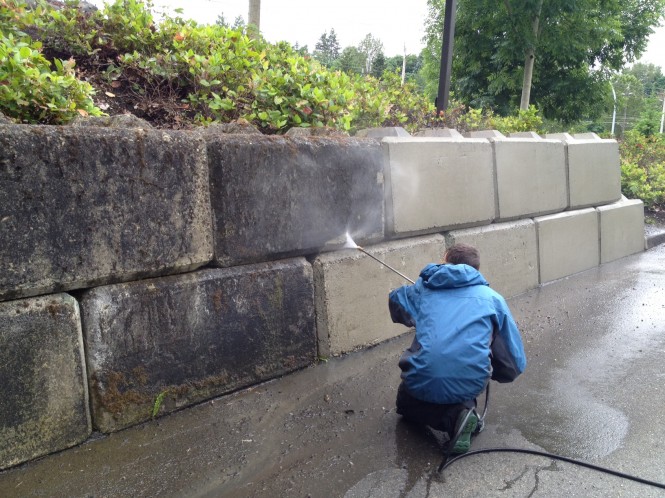
Retaining walls are not just functional—they add structure, style, and definition to your outdoor spaces. But over time, they collect dirt, moss, mildew, and even algae. Pressure washing can bring them back to life—but only if done carefully. Too much force, the wrong angle, or poor prep can cause serious damage. So how do you clean your retaining wall without ruining it? Let’s break it down. 👇
💡 Know Your Wall Before You Wash
First things first: not all retaining walls are created equal. The materials matter—a lot.
- Concrete block walls can usually handle moderate pressure.
- Brick and mortar walls require a gentler touch.
- Natural stone can be soft and porous, especially limestone or sandstone.
- Timber or wood walls need extremely low pressure and are often better hand-cleaned.
If you’re unsure about your wall’s material or structural integrity, test a small, hidden area first. 🔍🧱
🧽 Prep Is Everything
Before grabbing your pressure washer, do some groundwork:
✅ Clear the area – Remove debris, leaves, or loose soil from the base of the wall.
✅ Cover nearby plants – Use plastic sheets or tarps to protect surrounding vegetation 🌿🌼.
✅ Check the wall’s condition – Look for loose stones, cracked mortar, or signs of instability. If you see anything questionable, repair it before cleaning.
✅ Pre-soak the wall – A light mist from a garden hose helps loosen dirt and prevents streaking.
🚿 Choose the Right Settings and Tools
Your goal is to clean the wall, not blast it apart. Use these recommended settings:
- PSI: Stick between 1,200–2,000 PSI. This is enough to remove grime without eroding surfaces.
- Nozzle: Use a 25-degree or 40-degree tip for wider, gentler coverage.
- Distance: Stay at least 12–18 inches away from the surface.
- Spray Angle: Always spray at a downward angle, never directly into mortar or cracks.
If you spray head-on, especially at joints or seams, you risk blowing out the mortar or dislodging bricks or stones. 🚫🧱
🧴 Consider a Cleaner
Water alone may not be enough. For mold, mildew, or greasy stains, use a masonry-safe detergent or degreaser. Look for biodegradable or non-toxic formulas to avoid harming nearby plants or groundwater. ♻️🌎
Apply the detergent with a pump sprayer or detergent nozzle, let it sit for 5–10 minutes, and then rinse with your pressure washer on a low setting.
Browse Amazon Here For Biodegradable Pressure Washing Detergents
🧼 Step-by-Step Cleaning Guide
- Pre-soak the wall to loosen surface dirt.
- Apply detergent and let it dwell (5–10 mins).
- Start pressure washing from the top down using sweeping motions.
- Rinse thoroughly to avoid residue or streaks.
- Inspect the wall when finished. Let it dry fully before sealing or repairing any areas.
🧠 Pro Tips to Avoid Damage
- Never use a zero-degree nozzle – It’s too concentrated and can cut into stone or mortar.
- Avoid lingering in one spot – Keep the wand moving to prevent etching or gouging.
- Don’t overdo it – One thorough pass is often enough. Multiple passes can erode materials.
- Avoid pressure washing in freezing weather – Wet masonry expands and cracks when it freezes. ❄️🚫
🧽 What About Sealing the Wall Afterward?
Once your wall is fully dry (usually after 24–48 hours), it’s smart to apply a masonry sealer to protect against future staining, moisture intrusion, and moss growth. Choose a breathable sealant if your wall is natural stone or porous. 🧴🛡️
📌 Final Thoughts
Yes, you can pressure wash a retaining wall without damage—but only if you’re careful. Use moderate pressure, the right spray angle, and masonry-safe cleaners. Always inspect the wall before and after washing to ensure you’re not causing harm.
Done right, a good cleaning can restore the beauty and function of your retaining wall, making your outdoor space look fresh and inviting. 🌿🧼✨
Browse Amazon Here For Top Rated Power Washers And Accessories






